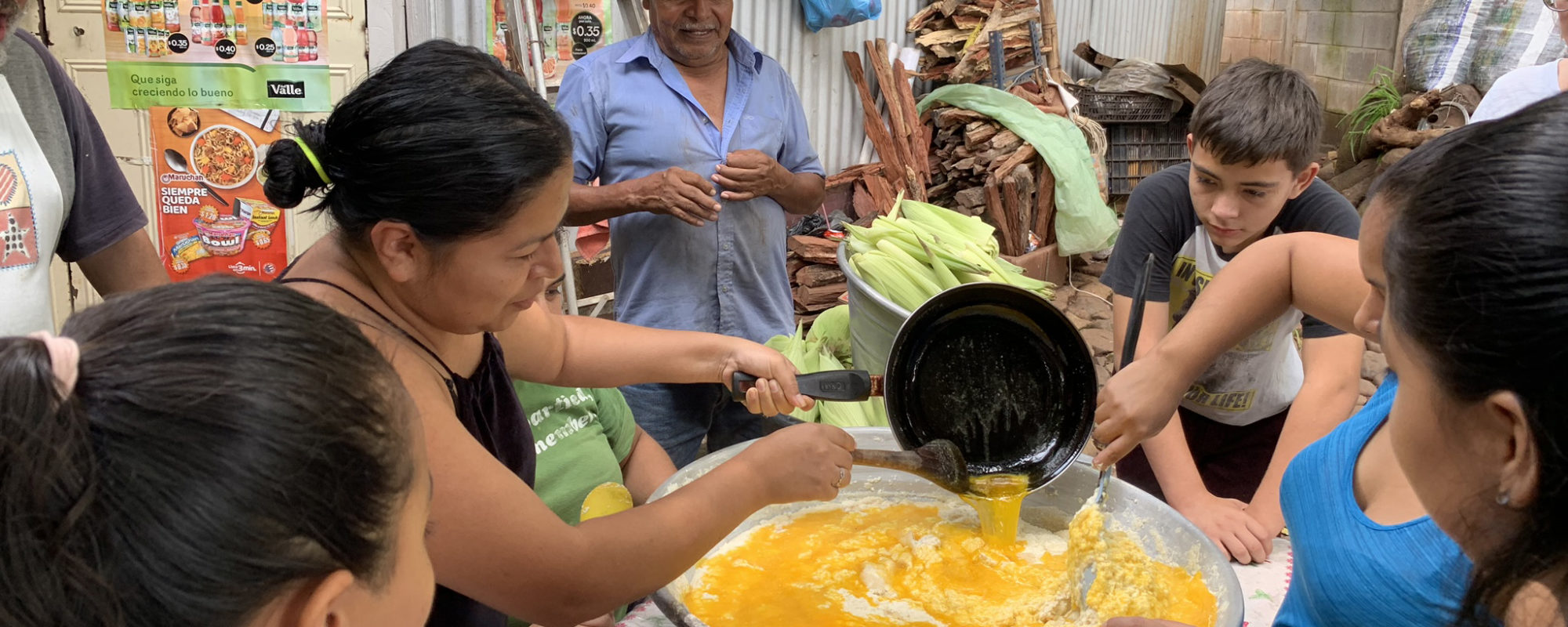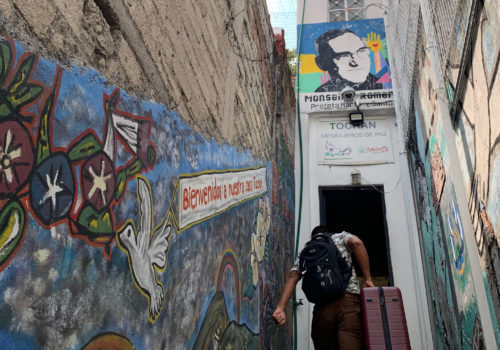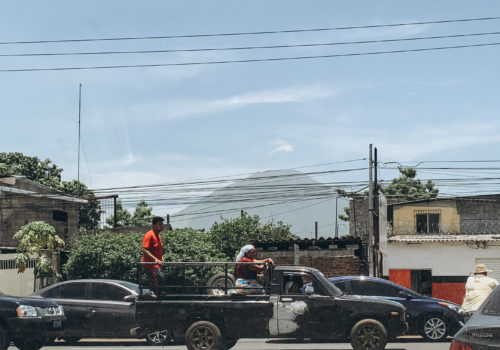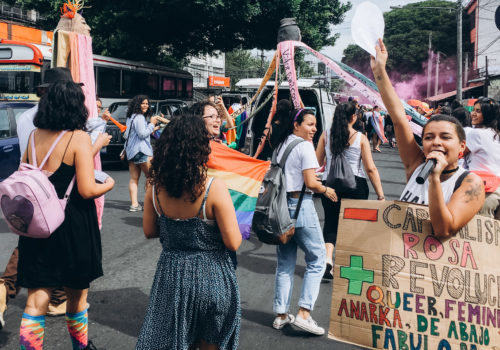CHILTIUPÁN, El Salvador — On a drizzly Sunday afternoon in late August, I huddled under an umbrella sipping from a steaming Styrofoam cup of creamy atol, a drink made from elote and milk. In my other hand, I held a fresh cob of elote, young sweet corn that had recently been harvested and donated by a local farmer for the town’s annual corn festival, the Fiesta de Maíz. The corn cobs and atol were being served under large tents across from the Santo Domingo church. It was my second weekend in a row feasting on corn in Chiltiupán, a village in the department of La Libertad, high in the mountain range that separates San Salvador from the coast.
A stage had been erected in front of the church. Before a trio of schoolgirls in traditional long ruffled dresses took to the stage with ceramic jugs to perform a slow choreographed dance, a man whom I took to be a Catholic priest reminded us that the town’s Mayan ancestors revered corn as a goddess. Corn remains a staple of the Salvadoran diet and a key part of this community’s identity. Even the entrance to the town is decorated with statues of corn cobs.
Nevertheless, most of the food on Salvadoran supermarket shelves is now imported from Guatemala, Mexico, Costa Rica and even the United States. Starting in the 19th century, much of the land that had traditionally been dedicated to subsistence farming was repurposed for export crops: first indigo, then coffee, sugar and cotton. By the 1880s, indigenous communal lands were broken up and appropriated by a small landowning elite that came mostly from Europe and the Middle East. That group is known as the oligarchy or, in a slight exaggeration, the “Fourteen Families.” Many of the rural people who traditionally farmed the land were displaced and forced to either migrate or work as conscripted laborers. The issues of land ownership, land reform and access to resources were at the root of major conflicts during the 20th century, such as La Matanza of 1932—a massacre of tens of thousands of peasants—and the Civil War from 1980 to 1992.
A majority of migrants from Central America come from rural areas, according to the Atlas of Migration published by the United Nations’ Food and Agricultural Organization and Economic Commission for Latin America and the Caribbean in December 2018. In order to better understand the complex factors behind this migration—which include the impacts of climate change and other environmental factors as well as violence and poverty—I jumped at the chance to get out of the capital and experience some of the rhythms of rural life. The week before the Fiesta de Maíz, I accompanied a family reaping its own harvest to put it to use on a special day they call the atolada.
The Atolada: A family tradition
Every year in early August, the family gathers together for the first elote harvest. Victor and Isabel and their children, grandchildren and great-grandchildren—many of whom live together on a plot of land just outside town, and others who have returned from nearby towns—participate in the family event. I was invited along because of my friendship with Regina, the partner of a family member who is currently in the United States.
I couldn’t help but pay attention to the family structure. Whether or not a “family” qualifies as a “particular social group” for asylum has been a hot topic in immigration law. In July of this year, US Attorney General William Barr issued an opinion stating that genetic ties are not sufficient to form a protected group but that the family must be “socially distinct in the eyes of society.”
As an outsider, I couldn’t always tell how everyone was related to one another. They don’t divide themselves neatly into nuclear family units: aunts, uncles and cousins step in to care for the children or discipline them. Still, it was clear that everyone here belonged to each other, and word quickly got around town that this family had a foreign visitor.
When we arrived around 9:00 a.m. the family had already been at work since dawn, bringing the corn down from the fields by horseback. (The work had actually begun two-and-a-half months before, when the seeds were planted at the start of the rainy season.) The husks had been removed and sorted, the good ones saved for the tamales we would make later in the afternoon. The cobs had also been sorted into hard and soft corn, and the softer ones taken off to be cooked and eaten on the cob. The harder ones were stacked and one of the two preteen girls handed me a knife and demonstrated how to shuck them by hand, scraping off the kernels into large buckets. The girls took great pleasure in showing me how to hold the knife to get the most out of each cob, cradling it in my left hand with the knife in my right, starting at the top and scraping in a downward motion.
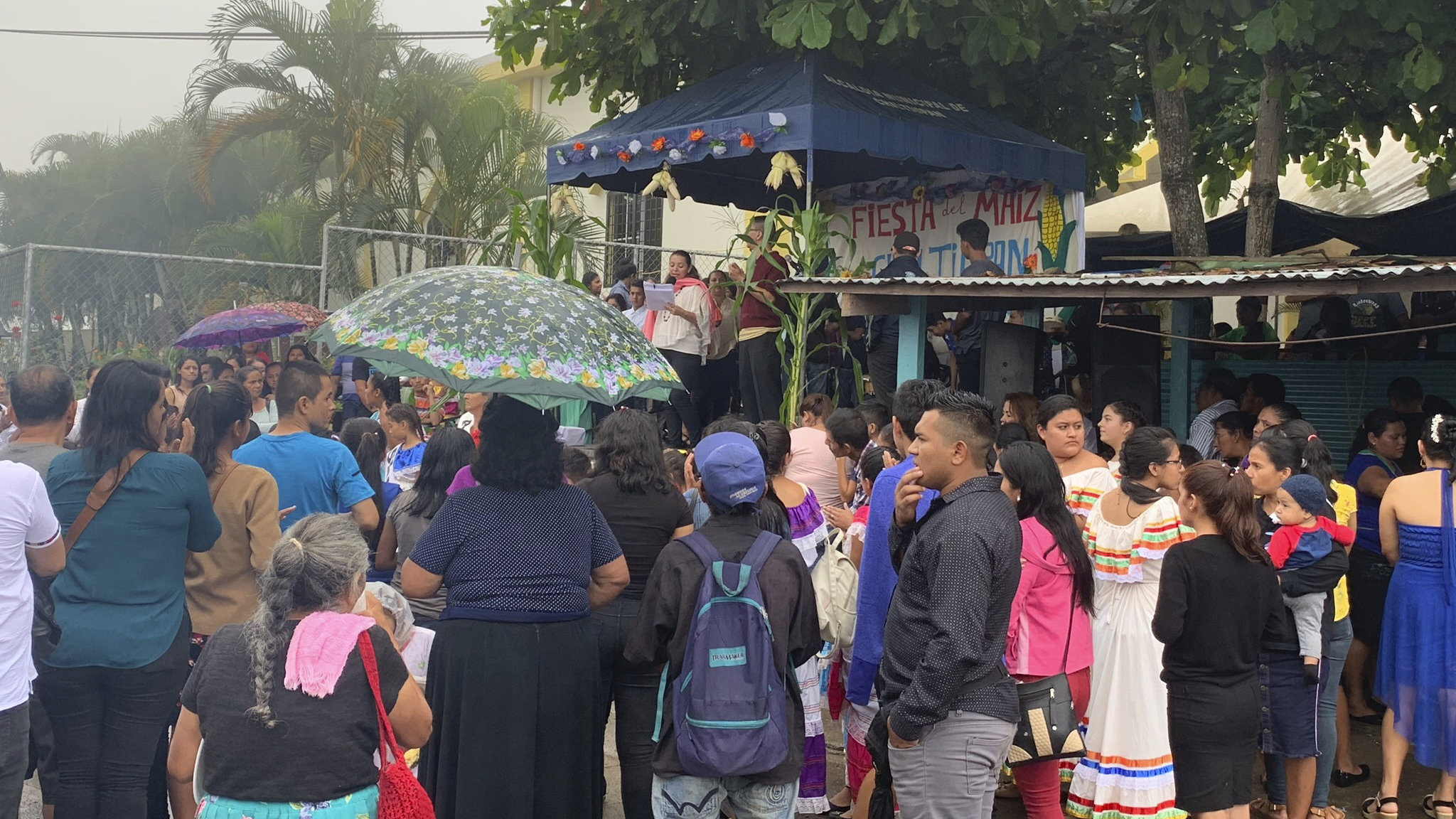
Once the buckets were full of corn, they were taken back into the kitchen and cleaned by sticking wet arms inside. The detritus would stick to the arms, leaving only the kernels. Then we loaded the buckets into my car and took them down to the town mill (molino). I was the only one with a car; if I hadn’t been there, it would have been at least a 45-minute walk each way. We saw other families carrying corn in sacks, leaning under their weight.
The molino is a small storefront on one of the town’s main streets across from the police station, and the miller has been working there for decades. As we waited, I remembered how one of my Salvadoran asylum clients in Seattle had explained to me that everyone in his town knew who he was because his mother operated the town molino. People come from all around for help with processing their fresh corn into dough (masa) they use to make tamales, atol, riguas and tortas. I learned that the young sweet corn we brought with us is not used for tortillas. Salvadoran tortillas, served with nearly every meal, are thicker than Mexican tortillas and made with more mature corn from a later harvest.
We took the buckets, now full of masa, back to the house, where one was brought to the kitchen and the other set on a large wooden table outside. Family members gathered around as additional ingredients including margarine and sugar were poured in. Different people tasted the raw dough until it was seasoned just right. Then I was shown how to select a husk and fill it partway with masa, then fold the husk around it into a tamal. Wendy, a granddaughter visiting from a nearby town, provided quality control, checking each tamal before putting it into the bucket. She expertly packed the husks tighter and folded them around to keep the dough from sliding out.
Throughout the afternoon, we were brought plates of corn on the cob with lime wedges and cups of atol. When I took a sip from my water bottle, I was warned not to drink too much, that it would react badly with the corn in my stomach. I wandered into the kitchen to see if I could help and was taught how to make riguas, molding the dough around a piece of cheese, then frying it on the stovetop.
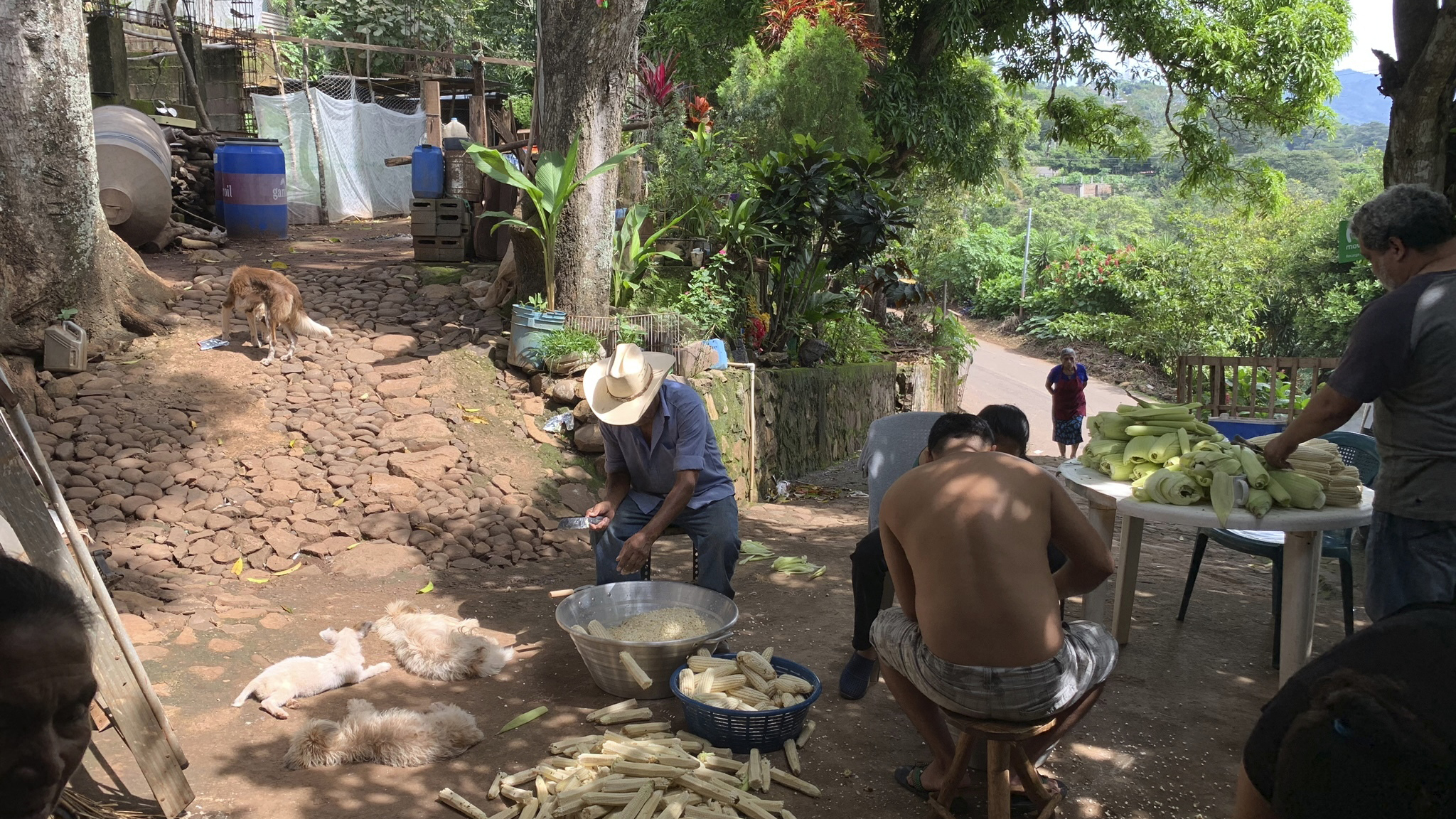
The night ended with elote loco (“crazy corn”), which had been eagerly anticipated all day. It turned out to be a corn cob on a stick slathered with mayonnaise, then squirted with generous amounts of a variety of sauces including ketchup, mustard, Worcestershire Sauce (very popular here in El Salvador, where it’s called “English Sauce”) and topped with grated cheese.
I wasn’t sure if I could possibly eat any more corn after the daylong feast. But when I gingerly took a bite of the elote loco, I knew there was no way I could eat it and no way I could give it back. The rich swirls of sauces were too much for my unaccustomed palate. As the others eagerly dug in, I took a paper towel and surreptitiously wiped off the sauce revealing the corn underneath and started nibbling at that. Once I’d consumed what I thought was a not-wasteful amount of corn, I discreetly threw what was left in the direction of the dogs and cats greedily eating away at the discarded cobs.
The tamales, which had been cooking on a wood fire, were packed into Ziploc freezer bags and we were given a few to take home and eat later.
Missing distant family
After the corn festival, we headed back to the house to visit. As it started to get dark, I became more anxious to go. The road back to San Salvador is winding and often foggy. On the way up, I had seen remnants of the original road, which had been destroyed in one of two major earthquakes in early 2001. Those earthquakes caused a humanitarian disaster so great it prompted the US government to grant Temporary Protected Status (TPS) to Salvadorans already present in the country. (President Donald Trump reversed that policy by announcing the termination of the program, but a federal court blocked the termination and the future of the nearly 200,000 Salvadoran TPS-holders in the United States depends on the pending litigation.) Landslides and trees and rocks still frequently block the way. But Regina insisted we stay for the piñata and cake. It was Leo’s tenth birthday, and both of his parents live abroad. He needed the whole family around him, she said.
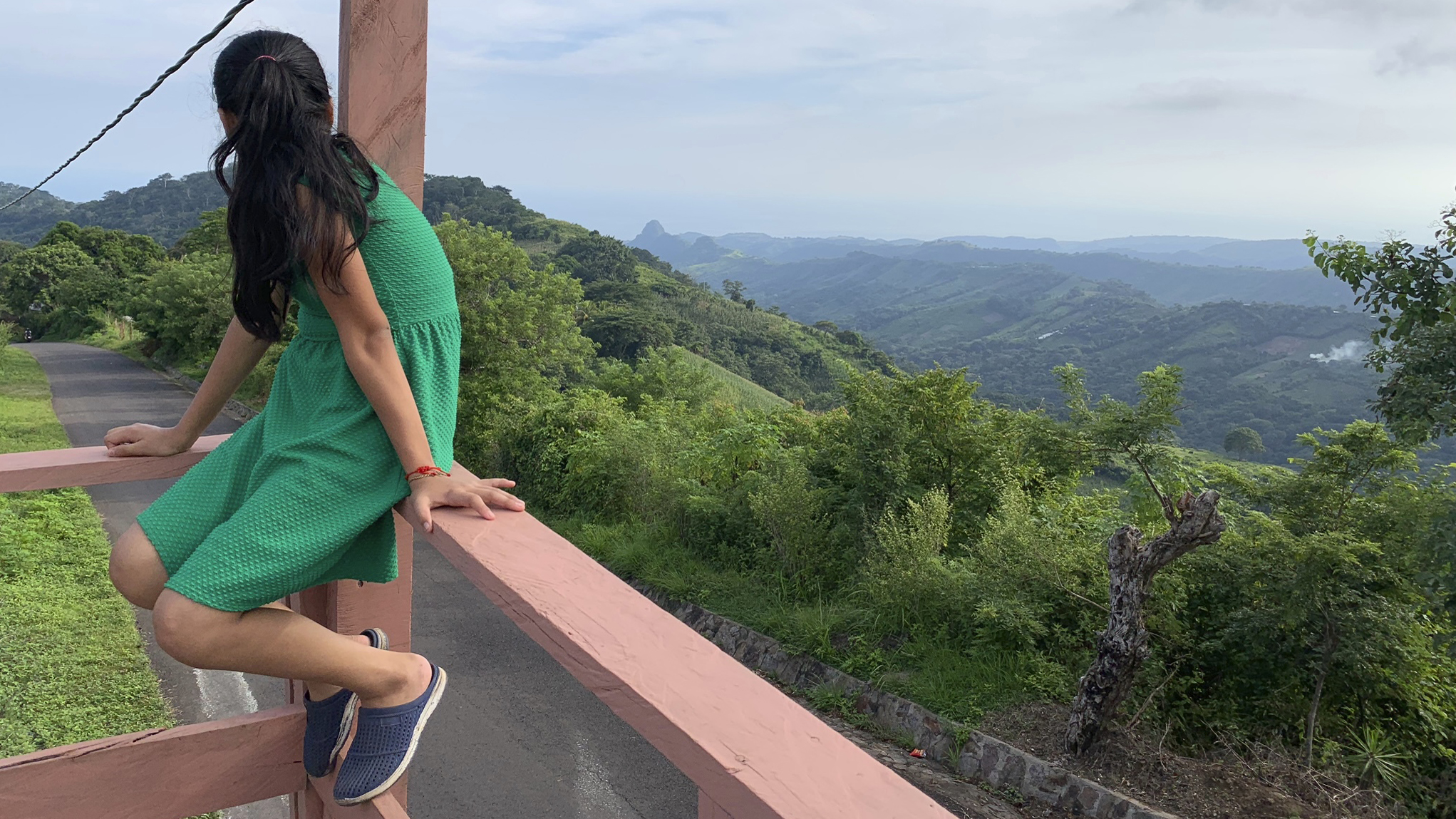
As I watched Leo and the other children (and a few of the adults) take turns swinging at the piñata and scrambling to pick up the bits of candy that scattered onto the dusty path leading to the road, I thought about how much I missed my own parents and how hard it would have been to grow up without them, even surrounded by a loving extended family. I wondered how many Salvadorans in the United States were messaging with their family members about the corn harvest and longing for the taste of fresh elote.
Don Victor, the patriarch, pulled up his chair next to mine and told me again how welcome I was. He said he understood why, being so far away from my family, I would want to be a part of his family’s event. When I asked about his family in the United States, he proudly described his granddaughter who was raised there, who speaks both English and Spanish and helps her mother at doctors’ appointments by translating. It was unclear to me whether he had ever met his granddaughter in person.
“I’d like to go visit them,” he confided. “But I don’t think I have enough money for a visa.” I understood he wasn’t necessarily talking about the visa fee itself, but the criteria the US government uses to allow visitors. To rule out people who might violate the terms of their visas by working illegally, the consulate asks for proof of income and assets as well as ties back home. That means only the relatively wealthy are able to travel with permission. It’s been only a few months since I left home and I already miss my folks, but many immigrant families are separated for decades because of immigration restrictions that discriminate against the poor.
“I’ve been thinking recently about applying,” Don Victor continued as I tried to think of what to say. I’m not used to having such conversations without giving legal advice, so I just listened. “Now that I have cañas (gray hairs), maybe they’ll be more likely to give it to me.” I smiled and told him I hoped he’d be able to go.
“We will have another harvest in November,” he told me. “The beans will be planted soon. And we’ll be harvesting the more mature corn that we use for tortillas. I hope you can join us.” I assured him I would.

